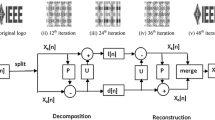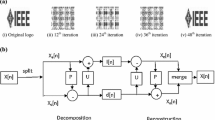Abstract
A novel adaptive gray scale image watermarking approach based on the combination of machine learning (ML) algorithms in wavelet domain is presented. Based upon fuzzy entropy information, non-overlapping and significant regions are selected. Lifting wavelet transform (LWT) is performed on selected significant regions in order to obtain low frequency sub band and underwent through the QR factorization. Prominent low frequency features of each region are supplied as input features for the training purpose of Lagrangian twin support vector regression (LTSVR) model. Then the optimal value of watermark scaling factor (strength) obtained using genetic algorithm (GA) is used to embed the watermark in the test data of output wavelet coefficient obtained by trained LTSVR. Arnold transformation is performed for the security of watermark along with the imperceptibility and robustness. The experimental results as well as the comparison between traditional methods and the proposed one showed a significant improvement in robustness in terms of image processing attacks which makes it suitable for implementing copyright protection applications.









Similar content being viewed by others
References
Agarwal C, Mishra A, Sharma A (2015) A novel gray-scale image watermarking using hybrid fuzzy-BPN architecture. Egyptian Informatics Journal 16:83–102
Ali M, Ahn CW (2015) Comments on optimized gray-scale image watermarking using DWT-SVD and firefly algorithm. Expert Syst Appl 42(5):2392–2394
Ali M, Ahn CW, Pant M (2014) A robust image watermarking technique using SVD and differential evolution in DCT domain. Optik 125(1):428–434
Ansari IA, Pant M (2017) Multipurpose image watermarking in the domain of DWT based on SVD and ABC. Pattern Recogn Lett 94:228–236
Avci E, Avci D (2009) An expert system based on fuzzy entropy for automatic threshold selection in image processing. Expert System with applications 36:3077–3085
Balasundaram S, Tanveer M (2013) On Lagrangian twin support vector regression. Naural Computing and Applications 22:S257–S267
Balasundaram S, Gupta D, Kapil (2014) Lagrangian support vector regression via unconstrained convex minimization. Neural Newtroks 51:67–79
Chu WC (2003) DCT based image watermarking using subsampling. IEEE Transaction on Multimedia 5(1):34–38
Cox IJ, Kilian J, Leighton FT, Shamoon T (1997) Secure spread spectrum watermarking for multimedia. IEEE Transaction on Image Processing 12(6):1673–1687
Daubeches I, Sweldens W (1998) Factoring wavelets into lifting steps. Journal of Fourier Analysisand Applications 4(3):247–269
Eyadat M, Vasikarla S (2005) Performance evaluation of an incorporated DCT block-based watermarking algorithm with human visual system model. Pattern Recogn Lett 26(11):1405–1411
Fan W, Chen J, Zhen J (2005) SPIHT algorithm based on fast lifting wavelet transform in image compression. In: Hao Y et al (eds) CIS 2005, Part II, LNAI, vol 3802, pp 838–844. https://doi.org/10.1007/11596981_122
Jagadeesh B, Kumar PR, Reddy PC (2016) Robust digital image watermarking based on fuzzy inference system and back propagation neural networks using DCT. Soft Computing (2016) 20(9):3679–3686
Klir GJ, Yuan B (1995) Fuzzy sets and fuzzy logic: theory and applications; prentice hall. Msm, New Jersey
Lian SU, Hong MA, Shifu T (2006) Adaptive image digital watermarking with DCT and FCM. Wuhan University Journal of Natural Sciences 11(6):1657–1660
Mangasarian OL, Musciant DR (2001) Lagrangian support vector machines. J Mach Learn Res 2001(1):161–177
Mehta R, Rajpal N (2013) General regression neural network based image watermarking using fractional DCT-II Transform. IEEE international Conference on Image Information Processing (ICIIP), pp. 340–345.
Mehta R, Rajpal N, Vishwakarma VP (2015) Robust image watermarking scheme in lifting wavelet domain using GA-LSVR hybridization. Int J Mach Learn Cybern 9(1):145–161
Mehta R, Rajpal N, Vishwakarma VP (2015) A robust and efficient image watermarking scheme based on Lagrangian SVR and lifting wavelet transform. Int J Mach Learn Cybern. https://doi.org/10.1007/s-13042-015-0331-z
Nikolaidis N, Pitas I (1998) Robust image watermarking in the spatial domain. Signal Process 66(3):385–403
Peng H, Wang J, Wang W (2010) Image watermarking method in multiwavelet domain based on support vector machines. The Journal of System and Software 83(9):1470–1477
Petitcolas FAP (2000) Watermarking schemes evaluation. IEEE Signal Process Mag:58–64
Rawat S, Raman B (2012) A blind watermarking algorithm based on fractional Fourier transform and visual cryptography. Signal Process 92(6):1480–1491
Shen R, Fu Y, Lu H (2005) A novel image watermarking scheme based on support vector regression. Journal of System and Software 78(1):1–8
Wang, S., Zhao, W., Wang, Z. (2008) A gray scale watermarking algorithm based on LU factorization.in IEEE International Conf. on Information Processing (ISIP). https://doi.org/10.1109/ISIP.2008.149, pp. 598-602.
Wu L, Deng W, Zhang J, He D (2009) Arnold transformation algorithm and anti Arnold transformation algorithm, in: Proc. of 1st International Conference on Information Science and Engineering (ICISE), pp. 1164-1167.
Xianghong T, Shuqin X, Li Q (2003) Watermarking for the digital images based on model of human perception. IEEE International Conference on Neural Networks & Signal Processing, pp.1509–1512.
Xinjun P (2010) TSVR: an efficient twin support vector machine for regression. Neural Newtorks 23(3):365–372
Yadav A, Mehta R, Kumar R, Vishwakarma VP (2016) Lagrangian twin support vector regression and genetic algorithm based robust grayscale image watermarking. International Journal of Multimedia Tools and Applications 75(15):9371–9394
Yadav A, Mehta R Kumar R (2016) Lagrangian twin SVR based grayscale image watermarking using LWT-QR decomposition. Networking Communication and Data Knowledge Engineering, LNDECT, 115–126.
Yao Z, Yen GG (2018) Evolving deep neural networks for movie box-office revenues prediction. IEEE Congress on Evolutionary Computation (CEC). https://doi.org/10.1109/CEC.2018.8477691
Yao Z, Yen GG, Zhang Y (2019) A knee-guided evolutionary algorithm for compressing deep neural networks. IEEE Transactions on Cybernetics 99:1–13. https://doi.org/10.1109/TCYB.2019.2928174
Zhang SQ, He N, Zang HY (2006) Research of the lifting wavelet arithmetic and applied in rotary mechanic fault diagnosis. J Phys Conf Ser 48:696–700. https://doi.org/10.1088/1742-6596/48/1/131
Author information
Authors and Affiliations
Corresponding author
Additional information
Publisher’s note
Springer Nature remains neutral with regard to jurisdictional claims in published maps and institutional affiliations.
Rights and permissions
About this article
Cite this article
Mehta, R., Gupta, K. & Yadav, A.K. An adaptive framework to image watermarking based on the twin support vector regression and genetic algorithm in lifting wavelet transform domain. Multimed Tools Appl 79, 18657–18678 (2020). https://doi.org/10.1007/s11042-020-08634-x
Received:
Revised:
Accepted:
Published:
Issue Date:
DOI: https://doi.org/10.1007/s11042-020-08634-x




